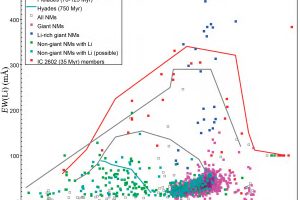A study on stellar clusters to calibrate the relation between Lithium abundance and age. The study: “The Gaia-ESO Survey: Calibrating the lithium-age relation with open clusters and associations. I. Cluster age range and initial membership selections” of M. L. Gutiérrez Albarrán (Universidad Complutense de Madrid) recently appeared on A&A

Determining stellar ages can be a difficult task. One of the main difficulties is due to the fact that methods to evaluate stellar ages are specialized for given types of stars and they do not work for the others. Besides, during the longest phase in stellar evolution, the Main Sequence, stellar parameters such as radius and temperature do not change significantly over time, and the lack of observables which change with time makes the estimate of stellar ages a challenging task. For instance, for a solar-type star, whose total lifetime is about 13 billion years, the main sequence last about 10 billion years, and during all this time stellar parameters are almost constant. One of the techniques used to estimate stellar ages in main sequence is by taking advantage of the decline of stellar rotation, and thus magnetic activity, with stellar age. A more recent technique, called “asterosismology”, consists in studying the stellar pulsation modes, which probe the stellar internal structure, from photometric measurements with high precision and temporal cadence. One of the methods used to find the age of giant stars is based on determining the chemical abundances of the stars. Stars in stellar clusters can be more easily dated since they constitute an almost coeval sample of stars. Two methods are typically used: The “isochrone fit” consists in comparing observed photometry with evolutionary models of stars, and it is mainly used for young clusters; the “turn-off point”, instead, is used with old clusters and it consists in determining the mass of stars in the cluster that just evolved off the main sequence.
One of the most effective methods to estimate stellar ages consists in measuring the abundance of Lithium from stellar spectra. Lithium, is in fact easily consumed in stellar interior already at temperatures of 2.5 million degrees (which, in a solar-type star, is the temperature at the base of the convective zone). In principle, thus, Lithium abundance in stellar surface declines with age and thus it could be used to determine stellar ages. Unfortunately, the decline with age of Lithium abundance depends also on other stellar parameters, such as stellar mass, internal structure, magnetic activity, and rotation. This makes difficult to calibrate the relation between Lithium abundance and stellar age.
The spectroscopic survey GES (Gaia-ESO Survey), which is based on spectroscopic observations on 10000 stars and about 100 clusters with FLAMES of the European Southern Observatory, offers a unique possibility to study the calibration between stellar ages and Lithium abundance. This is, in fact, the objective of one of the GES projects. The study: “The Gaia-ESO Survey: Calibrating the lithium-age relation with open clusters and associations. I. Cluster age range and initial membership selections” of M. L. Gutiérrez Albarrán (Universidad Complutense de Madrid) is the first paper published in the framework of this project. In this study the authors have determined the memberships of 20 stellar clusters with an age between 1 million years (the star forming region ρ Ophiuchi at a distance of 430 light years away from the Sun) and 4 billion years (the stellar cluster NGC2243, at a distance of 15000 light years from the Sun). Stellar members of the various clusters are determined throughout reliable diagnostics of memberships, such as the analysis of stellar radial velocity (i.e.: the component of stellar velocity along the line of sight). This is a first step: in future studies the authors will use this list of stars associated with stellar clusters in order to calibrate the relation between stellar age and Lithium abundance. They will also determine the nature of a peculiar type of giant stars rich of Lithium. The astronomers L. Prisinzano and R. Bonito of INAF – Astronomical Observatory of Palermo are co-authors of this study.
The figure (click here to visualize the entire image) shows the diagram of the Equivalent Width (EW) of Lithium 6707.84 Å line as a function of the effective temperature of the stars. In the diagram are shown: the members of the cluster IC 2602 (35 million years, about 500 light years away from the Sun); the limits of the locus populated by stars of the Pleiades (100 million years, 440 light years away) and the Hyades (625 million of years, 151 light years away), together with stars not associated with IC 2602 which can contaminate the selection of members: field stars with rotational velocity similar to that of cluster members, Lithium-rich giant stars, etc…
Mario Giuseppe Guarcello ( follow mguarce)
